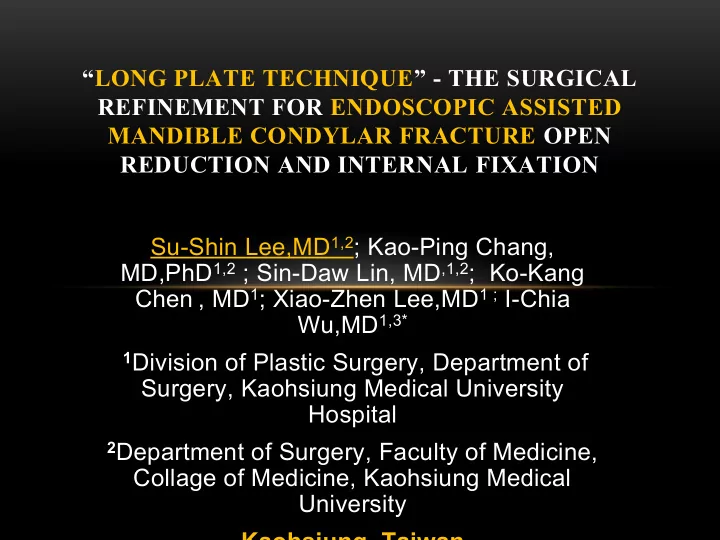

“LONG PLATE TECHNIQUE” - THE SURGICAL REFINEMENT FOR ENDOSCOPIC ASSISTED MANDIBLE CONDYLAR FRACTURE OPEN REDUCTION AND INTERNAL FIXATION Su-Shin Lee,MD 1,2 ; Kao-Ping Chang, MD,PhD 1,2 ; Sin-Daw Lin, MD ,1,2 ; Ko-Kang Chen , MD 1 ; Xiao-Zhen Lee,MD 1 ; I-Chia Wu,MD 1,3* 1 Division of Plastic Surgery, Department of Surgery, Kaohsiung Medical University Hospital 2 Department of Surgery, Faculty of Medicine, Collage of Medicine, Kaohsiung Medical University Kaohsiung, Taiwan
• level of fracture • dislocation at the point of fracture • the relationship of the condylar head to the articular fossa .
CONDYLAR FRACTURE TREATMENT OPTION CLOSE VS OPEN • The management of fractures of the mandibular condyle continues to be controversial. • Close reduction with intermaxillary fixation (IMF) 1. all condylar fractures that occur in childhood 2. Intracapsular fracture 3. Extracapsular fractures that do not include serious condylar dislocation in adults. • Open reduction 1. adults with displaced fractures 2. Adults with dislocation of the condylar head Int. J. Med. Sci. 2008, 5, Plast. Reconstr. Surg. 120 (Suppl. 2): 90S, 2007.
REPORTED RESULTS • 137 patients with unilateral fractures of the mandibular condylar process (neck or subcondylar) • 77 treated closed reduction + IMF • 65 treated open reduction with/without international fixation • The closed techniques group had a significantly greater percentage of malocclusion compared with patients treated by open reduction, in spite of the initial displacement of the fractures being greater in patients treated by open reduction. Ellis et al. Occlusal results after open or closed treatment of fractures of the mandibular condylar process. J Oral Maxillofac Surg 2000; 58: 260- 8.
REPORTED SURGICAL PROBLEMS • limited access • risk of damage to the facial nerve and its branches • postoperative auricular anaesthesia – paraesthesia due to injury of the greater auricular nerve • damage to parotid gland function (sialocele, fistula, etc.). ACTA otorhinolaryngologica ita lica 2010;30:303-309 . J Oral Maxillofac Surg 2000; 58: 260-8.
MATERIAL AND METHODS • From July, 2002 to August, 2012, there were 2278 facial bone fracture patients operated at Kaohsiung Medical University Hospital. • Chart, CT images and operation record were reviewed. • 59 condylar fracture patients . (Bilateral 14, right side 27, left side 18)
Standard method: Submandibular approach, 4 hole plate used + 2~3 weeks IMF 2 M f/u
HOW THE IDEA COME? • Condylar neck fracture need tragus approach for plating. • However, the 3 rd or 4 th hole of the 4-hole plate are very close to the facial nerve trunk. • Traction at this area Left facial nerve transient cause complication! paralysis, (5 months f/u OK)
During plating, the 3 rd or 4 th hole of the 4-hole plate are very close to the facial nerve trunk Lt Condylar head Left Facial nerve trunk 14 mm
LONG PLATE TECHNIQUE • Endoscope, 4mm, 30 degree • Submandibular approach • Tragus incision • Penrose drain for 3 days • 2.0 mm. 8-hole plate • 2 weeks IMF with wire + 1 week rubber band guiding traction.
Tragus incision to fix the first screw of plate at proximal segment
6 hole plate /8 hole plate used to fix the lower 3 or 4 hole with screws via the submandibular incision.
Bilateral condylar neck fracture Bilateral long plate technique used
RESULTS • 59 condylar fracture patients • Close reduction with IMF 21 patients • Open reduction with IMF 18 patients • Open reduction with 4 hole plate fixation 11 patients • After 2011-6 • Open reduction with long plate fixation 9 patients
ADVANTAGE • After finish the 1 st screw, the lower part of screws can be inserted under direct vision, thus shorten the op time. • Less risk to trauma the facial nerve trunk. (need more experience to verify this point) • Penrose drain for 3 days, no infection in this series .
Recommend
More recommend